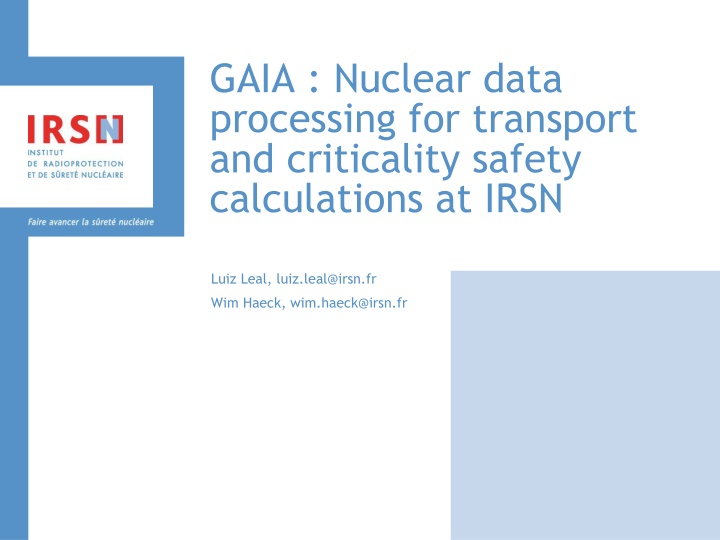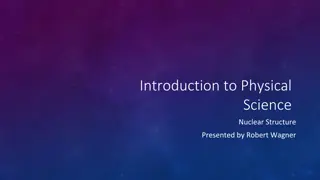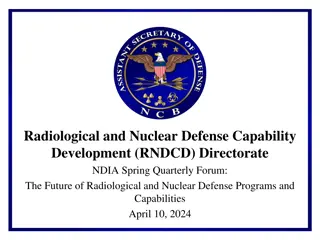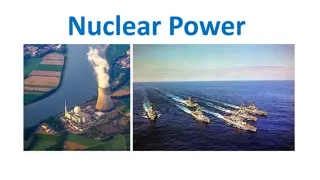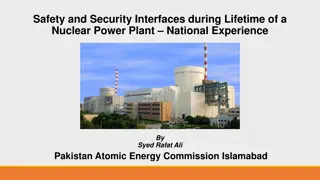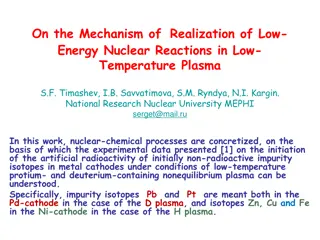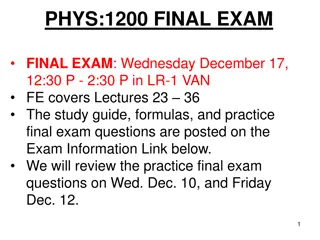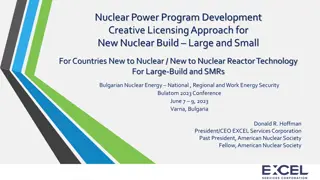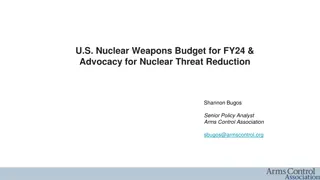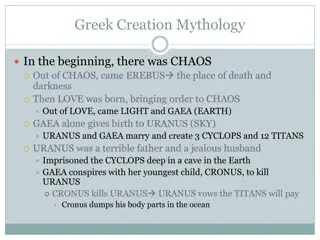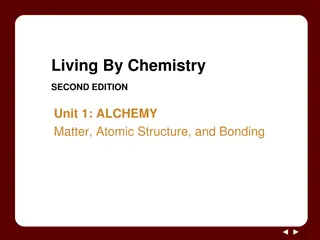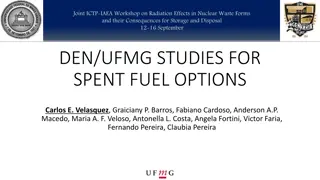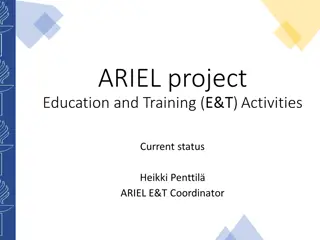GAIA Nuclear Data Processing Overview
GAIA is a software framework for nuclear data processing used for transport and criticality safety calculations. It offers features like library QA procedures, validation of neutronic simulations, processing using NJOY wrapper, and making application libraries. The tool can read/write various file formats and is utilized in generating libraries for applications like MORET5, MCNP(X), and VESTA. Detailed steps are emphasized to ensure proper library processing and validation. GAIA enhances collaborative development without heavy source license issues.
Download Presentation

Please find below an Image/Link to download the presentation.
The content on the website is provided AS IS for your information and personal use only. It may not be sold, licensed, or shared on other websites without obtaining consent from the author.If you encounter any issues during the download, it is possible that the publisher has removed the file from their server.
You are allowed to download the files provided on this website for personal or commercial use, subject to the condition that they are used lawfully. All files are the property of their respective owners.
The content on the website is provided AS IS for your information and personal use only. It may not be sold, licensed, or shared on other websites without obtaining consent from the author.
E N D
Presentation Transcript
GAIA : Nuclear data processing for transport and criticality safety calculations at IRSN Luiz Leal, luiz.leal@irsn.fr Wim Haeck, wim.haeck@irsn.fr
Outline Introduction GAIA 1.x.x Processing path Library QA procedures GAIA 2 Overview and features Application
Validation of neutronic simulations ND Processing S/U Analysis Transport MORET5 VESTA GAIA 1.x.x GAIA 2 MACSENS BERING Software Nuclear Data Integral Experiments Application system keff+ keff
Nuclear data processing using GAIA GAIA 1.x.x : An NJOY wrapper for data library QA Uses either NJOY 99 or NJOY 2012 Inherently limited to ENDF formatted files Current tool for application nuclear data library generation Libraries for MORET5, MCNP(X) and VESTA : ACE and PENDF files GAIA 2 : a nuclear data manipulation software framework Multiple ways of using the software As a standalone application As an integrated component in other applications (e.g. VESTA 3) Capable of reading and writing to and from various formats ENDF, GND, ACE and other formats Provide collaborative development without heavy source licenses
Making application libraries Before nuclear data can be used it needs to be processed Multiple tools exist: NJOY, PREPRO, AMPX Degrades data and renders it code dependent (CE versus MG, etc.) 3 essential steps in preparing a library: The library processing has been verified NJOY processing path selection justify and document everything Examine NJOY output understand everything and act accordingly Perform other necessary tests act accordingly The library needs to be validated for use Everything needs to be documented NJOY is not a black box and should not be treated as such!
Processing path in GAIA 1.0.0x moder 20 -25 reconr -25 -21 'AM241 - 293.6 K - JENDL 4.0 (NJOY 99.259)'/ 9543 0 0 0.001 0 0.01 5e-08 0 / broadr -25 -21 -22 9543 1 0 0 0 0.001 1e+06 0.01 5e-08 293.6 0 / moder -22 30 heatr -25 -22 -21 / 9543 5 0 0 0 0 / 302 318 402 442 444 / heatr -25 -22 -23 / 9543 6 0 1 0 2 / 302 303 318 402 442 444 / thermr 0 -21 -22 / 0 9543 16 1 1 0 1 221 2 / 293.6 0.001 5.0 gaspr -25 -22 -21 / unresr -25 -21 -22 9543 1 9 1 293.6 1e+10 1e+8 1e+6 1e+4 1e+3 3e+2 1e+2 3e+1 1e+1 0 / purr -25 -22 -21 9543 1 9 20 64 1 0 293.6 1e+10 1e+8 1e+6 1e+4 1e+3 3e+2 1e+2 3e+1 1e+1 0 / acer -25 -21 0 40 41 1 0 1 .02 / 'AM241 - 293.6 K - JENDL 4.0 (NJOY 99.259)'/ 9543 293.6 1 1 / acer 0 40 42 40 41 7 1 1 -1 / 'AM241 - 293.6 K - JENDL 4.0 (NJOY 99.259)'/ viewr 42 43 stop
Library QA : NJOY output An NJOY output file contains a wealth of useful information: The RECONR resonance reconstruction error estimation Various messages or errors to inform the user of certain situations Output from the HEATR run for kinematic checks Data from UNRESR that can be used to check results from PURR And last but not least: the ACE consistency checks It is important to understand everything and act accordingly when a problem is detected.
Library QA : NJOY output Something is wrong with this output for elemental sulphur Can you guess what it is? The original evaluation dates back to 1979, as old as I am Elemental sulphur with a non zero fission integral? It is not because it runs that it is correct. estimated maximum error due to resonance integral check (errmax,errint) upper elastic percent capture percent fission percent energy integral error integral error integral error 1.00E-05 1.00E-04 2.26E+00 0.000 3.58E+01 0.000 1.24E-01 0.000 1.00E-03 2.26E+00 0.000 1.13E+01 0.000 3.92E-02 0.000 1.00E-02 2.26E+00 0.000 3.58E+00 0.000 1.24E-02 0.000 1.00E-01 2.26E+00 0.000 1.13E+00 0.000 3.92E-03 0.000 ... 1.00E+05 1.10E+00 0.003 1.53E-03 0.038 2.01E-03 1.743 2.00E+05 5.86E+00 0.001 2.04E-03 0.247 1.30E-03 1.077 5.00E+05 2.48E+00 0.010 1.22E-03 0.866 6.59E-04 1.765 1.00E+06 1.52E+00 0.018 5.29E-04 1.057 2.69E-05 2.025
Library QA : NJOY output The case of non-positive elastic cross sections RECONR: ---message from emerge---nonpositive elastic cross sections found. Due to resonance reconstruction and effects the following: JEF 2.2: 61Ni, 128Te, 152Eu, 154Eu, 157Gd, 176Lu, 185Re, 240Pu, 241Am, 244Cm JEFF 3.1: 40Ar, 61Ni, 111Cd, 113Cd, 128Te, 157Gd, 182W, 244Cm ENDF/B-VI,8: 56Fe, 57Fe, 61Ni, 74Se, 78Kr, 80Kr, 84Kr, 84Sr, 111Cd, 113Cd, 112Sn, 114Sn, 230Th, 238Pu, 242Pu, 244Pu , 242Cm, 244Cm, 248Cm, 250Cf, 252Cf What should you do? Plot it to see how bad it is Look at the other cross sections to see the overall influence
Library QA : ACER consistency tests The case of 11B from JEFF 3.1: No problems found ace consistency checks ---------------------- check reaction thresholds against q values check that main energy grid is monotonic check angular distributions for correct reference frame check angular distributions for unreasonable cosine values check energy distributions check photon production sum check photon distributions checking particle production sections proton production: checking energy distributions alpha production: checking energy distributions no problems found
GAIA 2 : A nuclear data processing software framework
Objectives GAIA : a nuclear data manipulation software framework As a standalone application As an integrated component in other applications Objectives Library generation for current (ACE and PENDF) and future tools Capable of reading from multiple nuclear data evaluation formats ENDF, GND and future formats Manipulation of data outside of the scope of existing tools Resonance reconstruction & Doppler broadening in a single step Thermal scattering data DPA and heating cross sections Provide collaborative development without heavy source licenses
Using GAIA as a standalone tool In short: sequential modules using an internal data object for information exchange
Using GAIA inside other software In short: to manipulate the data or make it compatible with what the software needs
GAIA features Prototyping and method development for independent capabilities at IRSN (G. Ferran and W. Haeck) Resonance reconstruction based on R-matrix formalism Multiple options for Doppler broadening including reconstruction Fast Fourier transformations Gauss quadrature Calculation of angular dependent cross-section data from resonance parameters (Blatt and Biedenharn formalism) Future developments Unresolved resonance treatment Thermal scattering law treatment - S( , ) Uncertainty processing: variance and covariance
GAIA features ENDF RECONR GAIA 2 BROADR PURR ACER ACE Library
GAIA features Single-Level Breit-Wigner Multi-Level Breit-Wigner R-Matrix Adler-Adler Reich-Moore Multipole R-Matrix Limited: ENDF format
Application Benchmark: ALARM-CF-FE-SHIELD-001 ICSBEP IPPE, Russia Neutron and photon leakage spectra from Cf-252 source Six iron spheres of diameters of 20, 30, 40, 50, 60, and 70 cm
